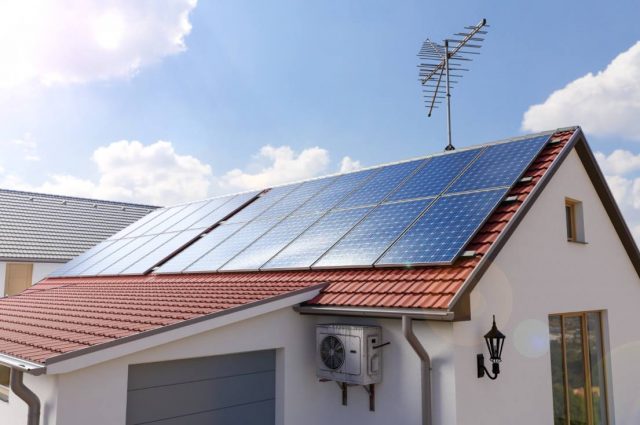Harness the power of the sun and transition to solar energy. Solar power represents a substantial solution to many global environmental challenges. By transitioning, you’re revolutionizing your home’s relationship with electricity.
Understanding Solar Energy
When we speak of solar energy, what do we mean? Solar energy is obtained from the sun’s radiation. This energy is converted into thermal or electrical forms, powering household appliances and lighting.
The process of generating electricity from sunlight involves solar panels absorbing sunlight. When the sun’s rays hit these panels on your rooftop, the panel cells get activated and start a flow of electricity.
Benefits of Solar Conversion
Transitioning to solar power has considerable benefits for our environment. It reduces greenhouse gas emissions, contributing to lesser global warming. The rise in sustainable living aids the environment and homeowner’s finances.
Apart from environmental benefits, there are financial advantages too. After transitioning to solar power, you can anticipate a monthly reduction in your electricity bills. As electricity rates rise over time, your savings will only grow. Lastly, by choosing solar energy, you’re reducing dependence on grid electricity.
Installation Process
Successful setup includes finding the right professional installer. Compare solar quotes from multiple providers before you finalize an installer. Once done, home surveying, installation planning, permit applications all come into play before actual implementation begins.
Regular maintenance checks help sustain system performance while minor troubleshooting prevents small problems from becoming significant issues later on.
Home Solar System Components
You will need several components for a complete solar setup at home.
- Solar Panels: Capture sunlight and convert it into electricity.
- Inverters: Convert the ‘direct current’ (DC) generated by solar panels into alternating current (AC) that household appliances can use.
- Batteries: Store any excess power produced during daylight hours for later use.
- Meters and Connectors: Measure the flow of electricity ensuring all parts function smoothly together.
Types of Solar Installations
Depending on your requirement and convenience, you can select the type of installation best suitable for you,
- Rooftop Installations: Best suited for those who have suitable rooftops and good exposure to sunlight.
- Ground-Mounted Systems: Ideal if your rooftops are shaded or structurally unfit for installing panels.
- Portable Solar Kits: Perfect for those who desire mobile solutions like campers or frequent travelers.
Determining Your Home’s Suitability
There are factors to consider when installing solar panels including if your home is suitable. Your home’s suitability for a solar system depends heavily on sunlight availability.
The amount of sunlight directly affects how much electricity your system generates. Moreover, understanding your household’s typical consumption rate helps in deciding the size of your desired setup.
Costs and Financing Options
Initial costs involving hardware purchasing or financing could seem daunting initially but when factored with long-term savings they make sense. Government solar assistance can lighten this financial commitment in terms of grants and rebates based on where you stay.
Optimizing Solar Energy Usage
If you truly want to embrace all the financial and environmental benefits that solar energy brings to your home, taking steps to optimize energy usage is just as important. Many homes waste an exponential amount of power due to inefficient habits and outdated appliances.
To further improve cost-efficiency, take steps to reduce overall energy consumption in your home alongside moving to solar solutions.
Energy Saving Techniques
Start with simple solutions such as using LED lights for lighting purposes. They use significantly less power than traditional bulbs and last much longer. As a result, the number of kilowatts needed from your solar panel system decreases, which eventually reduces pressure on system performance and boosts its lifespan.
Other ways to increase energy efficiency through upgrades include modern heating and cooling systems. As well as renewable energy sources.
Smart Home Integrations
Many homeowners are turning to smart home integrations for improving their overall energy efficiency. Integrate programmable thermostats that can adjust room temperature according to outside weather and the occupant’s lifestyle patterns. Install occupancy sensors to control lighting in rooms automatically.
These technological solutions paired with sensible energy-saving practices will ensure you’re making the absolute best out of your solar conversion, maximizing cost savings, and further reducing your home’s carbon footprint.
The Benefits of Smart Home Integrations
These lifestyle adjustments go hand in hand with transitioning to solar power – each one enhances the effectiveness of the other. As you control and curb wastage in your domestic power consumption, it is like supplementing your transition journey towards adopting solar power.
By making this two-sided effort, you not only experience an immediate reduction in energy costs but also celebrate a greener way of life that contributed generously towards wealthier conservation for years overhead.
The Takeaway
Despite appearing challenging initially due to multiple factors at play from selection to installation, transitioning to solar energy holds great potential benefits waiting to be tapped into, both environmental and fiscal.
Putting effort into selecting reliable components and choosing suitable installations ensures an efficient system that lasts longer delivers unrealized benefits unfolded every day as clean energy is harnessed right at home.

Speaks from heart, always too passionate and driven by emotions. Spins the words with kindness & sharpness, intriguing your ever-inscrutable minds.




